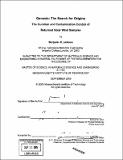| dc.contributor.advisor | Samuel M. Allen. | en_US |
| dc.contributor.author | Jackson, Benjamin K | en_US |
| dc.contributor.other | Massachusetts Institute of Technology. Dept. of Materials Science and Engineering. | en_US |
| dc.date.accessioned | 2006-07-31T15:17:19Z | |
| dc.date.available | 2006-07-31T15:17:19Z | |
| dc.date.copyright | 2005 | en_US |
| dc.date.issued | 2005 | en_US |
| dc.identifier.uri | http://hdl.handle.net/1721.1/33615 | |
| dc.description | Thesis (S.M.)--Massachusetts Institute of Technology, Dept. of Materials Science and Engineering, 2005. | en_US |
| dc.description | Includes bibliographical references (leaves 61-62). | en_US |
| dc.description.abstract | The purpose of the studies carried out in this thesis was to aid in the curation of samples of solar wind returned to earth on the Genesis spacecraft. An experimental study was carried out to aid development of a set of protocols for the laser scribing and subdivision of the Genesis silicon collector array materials. Optimisation of the scribing speed and the positioning of the focal point of the laser were carried out. It was found that scribe width was independent of both factors. Slower scribing speeds were found to produce deeper scribes, while heating effects were minimised with faster speeds. Vertical movement of the stage of 5 pm/pass was found to optimise the focal point of the laser, and minimise heating effects. A procedure to measure the flexural modulus of samples was proposed to quantify the success of the optimisation of the scribing parameters. A theoretical study was carried out to develop a predictive kinetic model for the oxidation of the silicon collector arrays during flight. The mechanism proposed for the increase in oxide thickness over that present pre-flight was the formation of a less-dense suboxide at the SiO₂/Si interface. The driving force is the elevated temperature of the collectors during collection, in the vacuum of space. | en_US |
| dc.description.abstract | (cont.) A kinetic model was developed and growth rate expressions derived for two limiting kinetic cases. It was not possible to apply these expressions to the Genesis sample conditions, as the measurement of several experimental parameters was beyond the time limits of this study. A second model was developed alongside literature models to reduce further the number of unknown variables. Finally, the maximum possible thickness of oxide that could grow on the silicon surface was calculated. This was found to be 25 A, representing a 47 % increase over the original 17A of SiO₂ present pre-flight. It was noted that there was a non-linear increase of total oxide thickness with increase in suboxide thickness to due to density differences between Si and SiO, and SiO₂ and SiO. | en_US |
| dc.description.statementofresponsibility | by Benjamin K. Jackson. | en_US |
| dc.format.extent | 62 leaves | en_US |
| dc.format.extent | 4953582 bytes | |
| dc.format.extent | 4956146 bytes | |
| dc.format.mimetype | application/pdf | |
| dc.format.mimetype | application/pdf | |
| dc.language.iso | eng | en_US |
| dc.publisher | Massachusetts Institute of Technology | en_US |
| dc.rights | M.I.T. theses are protected by copyright. They may be viewed from this source for any purpose, but reproduction or distribution in any format is prohibited without written permission. See provided URL for inquiries about permission. | en_US |
| dc.rights.uri | http://dspace.mit.edu/handle/1721.1/7582 | |
| dc.subject | Materials Science and Engineering. | en_US |
| dc.title | Genesis : the search for origins : the curation and contamination control of returned solar wind samples | en_US |
| dc.type | Thesis | en_US |
| dc.description.degree | S.M. | en_US |
| dc.contributor.department | Massachusetts Institute of Technology. Department of Materials Science and Engineering | |
| dc.identifier.oclc | 64391014 | en_US |
